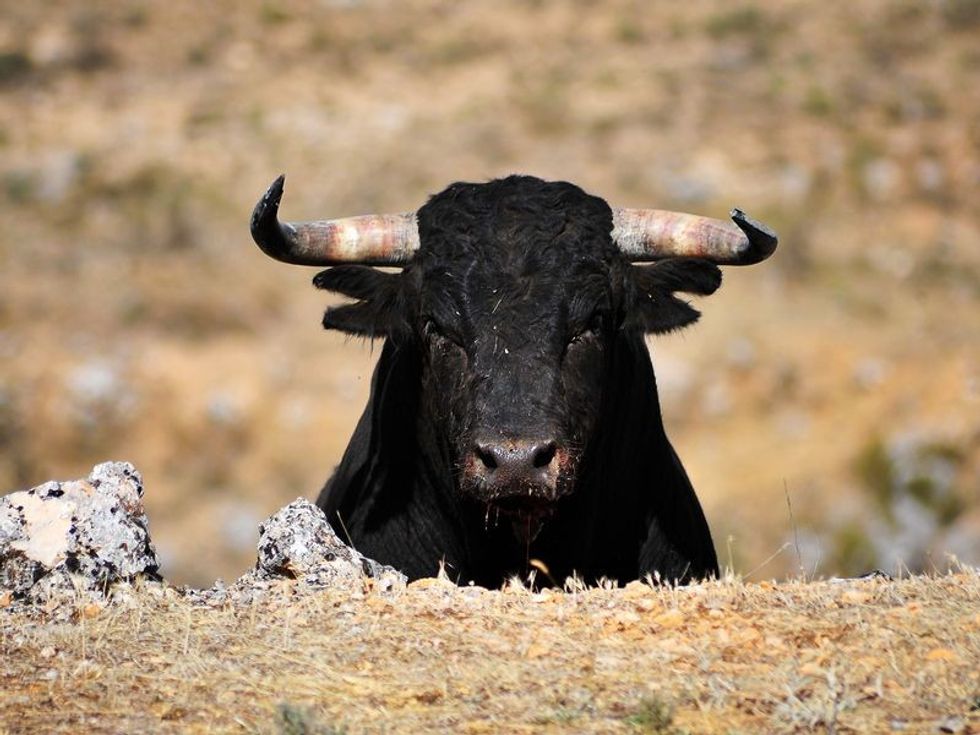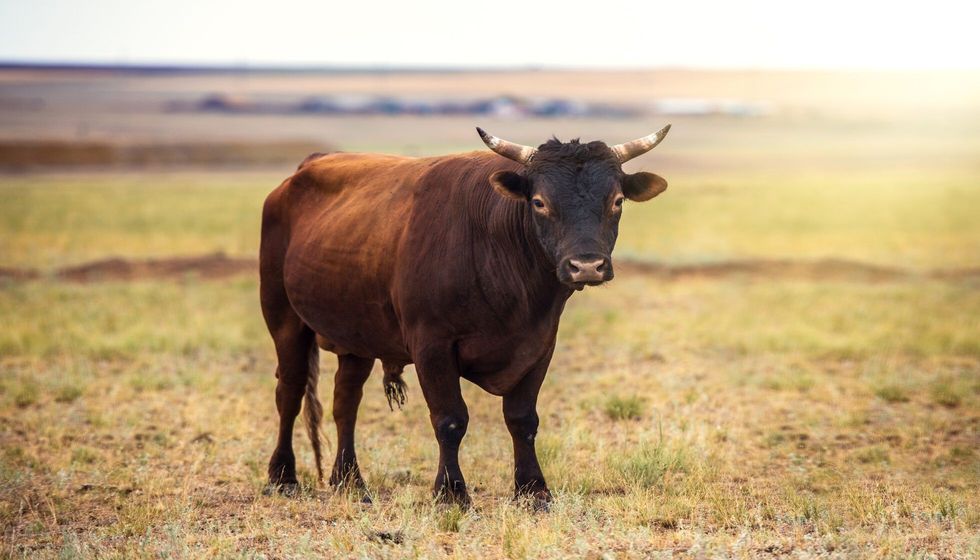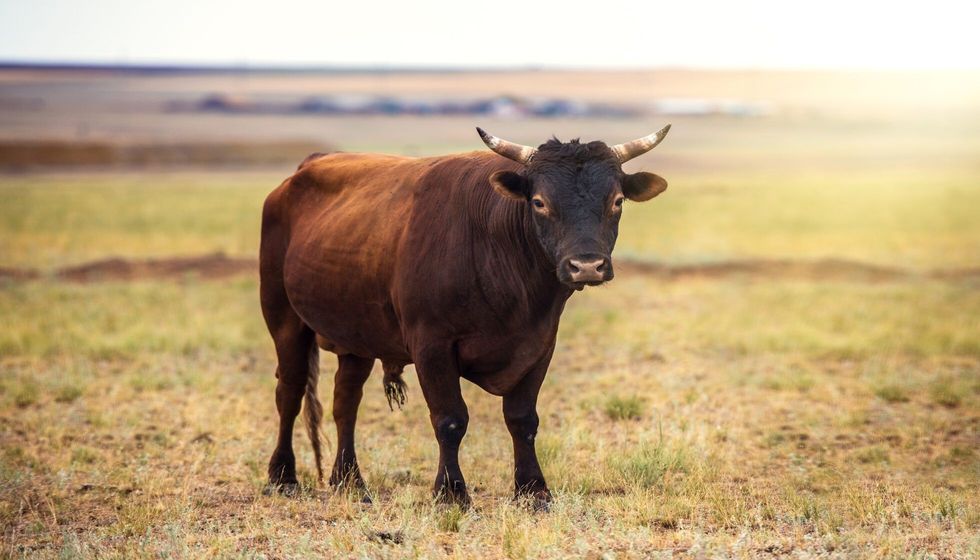Are Bulls Color Blind? Why Do They 'See Red' During Bullfights?

A bull is a male cattle; there are many cattle species like Hereford and Angus, which are kept on ranches throughout America.
Your average bull weighs around 1700 lb (771 kg). Bulls have a diet that consists of high protein, which is essential for a bull’s health to be maintained.
You have probably heard of ‘bullfighting’ from movies and other forms of media around you. Bullfighting or La Fiesta Brava is a big Spanish event.
People from around the globe come to Spain to witness these bullfighting events in bull rings. In bullfighting, a matador is the main performer who works with the red cape and a sword.
In the majority of the cases, the matador always ends up with an upper hand and kills off the bull, and if proper behavior is showcased by the bull, his life is spared.
After the bull has been defeated, the body of this beast is dragged out of the bull ring and processed in a slaughterhouse. After the event, the meat of the bull is distributed among the people.
The art of bullfighting is a tragedy and a business which has existed for centuries. But in fact, the bull is really color blind and always charges at the cloth which is moving irrespective of the color.
But why do you think an angry bull decides to charge for the red cape whenever waved in front of him?
Read further to understand why a bull charges at red color if it is color blind. After reading all about why bulls charge at the matador, do read why do bulls have nose rings and why do cows wear bells?
Why is red used in bullfights?
Bullfighting is indeed one of the most popular and controversial customs of Spain. People specially visit the country to see a bullfighter wave his cape in front of a bull. Is there any specific reason why a red-colored cape is used?
You might think that angry bulls hate the color red, but that’s not the case. The reality is that bulls do not get angry by any color, literally.
There is little to no evidence that can prove that your average bull decides to charge just because of seeing a specific color. The way angry bulls perceive colors is completely different when compared to humans.
The reason behind a bull charge is not the color red; it is the movement of the matador’s muleta. A cape of any color such as green, yellow, white, or even blue would make the bull feel irritated the same way as a red cape would do.
Bulls cannot see any color; they are color blind.
The reason why we see the matador waving red muleta is that the color red has a high wavelength which lets it be visible from stands for the people to watch. Red muleta also masks the blood of the bull after the matador takes it down.
Red muleta has been used for bullfighting since the 18th century. Hence, the association of bull charging rapidly at the waving rich red muleta is now stuck inside people's heads.
These ornate costumes and red muleta are now seen as part of the bullfighting culture. Red capes are now seen as part of a matador’s uniform.
Bulls have a dichromatic vision. That means they have two different cone cells in their retina, which detect colors.
One of the cone cells in the bull’s eye can detect short wavelengths around the 444 nm range, which is for the blue/violet region of colors. The other cone can detect longer wavelengths around the 552 nm range, which is the yellow/green region of colors.
Bulls, like many other cattle breeds, mammals, and animals, cannot see red; they are essentially color blind creatureswho cannot see the color red.
Ethics Of Bullfights
The sport of bullfighting has its roots that date back centuries. In the modern Spanish style, which we are used to seeing today, bullfighting became an important cultural event in the 18th century.
Many people and activists throughout the globe consider bullfighting to be a sport that is cruel for bulls as they are tortured and have a horrible death at the end of the event.
Animal rights groups have protested against this event and have tried raising awareness for animal cruelty. At one point in time, many states in Spain and France banned this sport.
However, in 2003, Spain declared bullfighting to be considered a National Cultural Heritage.
In Spain, you would not hear people calling this a ‘sport.’ It is considered a cultural event. In a way, you can say it’s an art as well because of how well the matador is trained to take on the bull, and you can see the emotions displayed in the bull ring.
But the fact that an animal is tortured and mentally strained just for the enjoyment and amusement of humans is definitely not ethical in any way possible.
Many people try to argue against this by saying that common pasture land can be preserved, but that can still be done without a bullfight.
Another argument which is given by the supporters of bullfighting is that if bullfights had stopped, the fighting bull species would disappear. Preserving species is actually a moral good, but we also need to look at the costs it is bringing.
You might be surprised that even though bullfighting is considered to be Spain’s culture, still the biggest bull ring is in North America.
Spain’s biggest bull ring is in Madrid.
There are many other unethical activities done in these countries using bulls, such as fire bull where flaming materials are attached to the bull’s horns, and then the bull is taunted as he tries to shake his head in order to get rid of the flames on his horns.
Another activity in Spain, by the name of ‘Encierros,’ is conducted where participants of the event run in front of chasing bulls and many people are admired for running close to bulls.
Bullfighting is based on acts of physical violence to the bodies of bulls.
These acts of physical violence are done using picadors and wooden sticks by matadors, which causes pain, injury, suffering, and the eventual death of a bull. The moral justifications are not worthwhile if the animal is being killed for the sake of entertainment.
Regardless of all the facts, it does not look like the event will end.

How many colors can a bull see? Which ones?
It is very common for people to think bulls and other cattle species are entirely color blind. However, this is not true; their perception is a bit different than ours.
The perception of the world from a bull’s eye is a lot different. A bull or cattle’s view is only 60 degrees compared to a human’s 140-degree vertical vision.
Bull or cattle cannot focus on any kind of object that quickly because they don’t see objects that clearly to begin with.
It takes a lot of time for a bull or cattle to register movements through their eyes. Bulls have blindspots behind their tails, and in order to focus on objects which are on the ground, they have to lower their head.
Bulls see colors at a much lower intensity compared to human beings. The only few colors which a bull can see seems to appear faded for the bull.
Bulls are generally known to be color blind to colors such as green and red. For a bull, every shade of green and red appears to be gray and black.
Contrary to what many people think that the red color makes a bull angry, it is not true.
Again, it is the moving of muleta that makes the bull’s blood boil and makes him charge towards the red cape. Several experiments have proved this; an angry bull will make a rush for any color cape that waves.
During an experiment conducted by researchers, three test dummies were wrapped in similar colors. The bull attacked all three dummies, and in fact, the red color dummy was the last one to be charged at by the bull.
Bulls are able to see shorter wavelength colors like orange and blue much better as compared to colors like green which they cannot see well due to longer wavelength. Bulls can see colors like yellow and blue, but they appear in a very faded manner to them because they only have two receptors for colors.
Bulls and cattle have a really poor depth perception which means they cannot tell how far they are from an object.
Which other animals are color blind?
Many other animals are considered to be color blind. Rod and cone cells in our eyes allow us to process and see colors such as red, green, blue, and yellow. Certain animals have a better night vision and see colors differently than us. Some of the most well-known color blind animals are the following.
Whales – Few species of whales have an excellent vision which allows them to look at faraway distances properly without any sort of issues.
As whales dive deeper into the ocean, their ability to see colors become less as there is less light at the bottom of the ocean, and it makes all of the colors down there look the same.
It’s not like whales do not have receptors at all; the ability of an eye to see colors depends on the color receptors of the retina.
Whales have a comparatively fewer number of cones when compared to the rest of the land animals, which tells us that they are color blind or have a vision that allows them to see only a limited number of colors.
A whale’s eyes allow it to perceive light in a very effective manner in darker areas of the ocean and at much greater depths, unlike land animals.
In addition to their eyes, whales use the ability which is known as ‘echolocation’, which allows identifying objects that are nearby in the ocean.
Whales send sound into the ocean and listen to echoes that return from the objects on which the sound touches upon.
Whale’s eyesight combined with echolocation makes whales very sensitive to the environment around them, and they are able to detect danger, food supplies nearby, and other things which are essential to survive in the freshwaters.
Deers – Deers are color blind as well. A deer’s perception of the world is a lot different than ours.
Rod cells enable us to keep track of movements and motion around us, while cone cells enable us to focus on the details.
We have three types of cones that allow us to see red, blue, and green; like bulls, deers only have two types of cones in their eyes which means they can only see blue and red but not green.
If an animal has a limited number of cones in its eye, it makes them perceive a limited number of colors. Deers cannot tell the difference between green and red.
However, they can see the color blue more clearly and can differentiate between the shades of blue.
They cannot see the red color. Due to having a higher concentration of rod cells, a deer’s night vision is much better.
The pupils of deer allow more light to enter, which adds to their better night vision. Deers have 310 – 315 degrees of viewing angle, much larger than bulls or humans, and they can detect moving objects around them easily.
This is something that makes them unique and helps them to defend against predators. Hunters are always dressed up in cameo patterns and not in red color gear when going for deer hunts which makes them blend in with the environment in front of deer much better.
Cats – A cat’s sight is much different than ours. These tiny hunters have a very small amount of cones in their eyes which makes a lot of people first think that they are totally blind when it comes to colors.
However, this is far from the truth.
They may not be able to see the world with the same colors as humans do, but they do not see the world in black and white either. A cat’s vision is more sensitive to wavelengths of blue and yellow-green.
However, their vision is weak against the combination of red-green. You might put it together and think that color blindness means seeing the whole world in black and white, but that is not true.
It is simply the ability to not be able to distinguish between certain colors such as red, green, white, blue, or even yellow. However, a cat’s night vision is unparalleled when compared to humans.
As they have a higher concentration of rods, their night vision is drastically improved and compensates for their lack of ability to see the color red and its shades.
They can clearly detect movements in complete darkness as well. A cat’s viewing range is only 20 ft (6 m), and it will likely have problems focusing on objects that are near its face.
Elephants – Elephants are another set of land animals who are color blind. Elephants have amazing eyes, which come in colors such as light brown, gray, and honey brown.
However, this does not help an elephant’s poor eyesight, and elephants also happen to be color blind.
Elephants can see your average yellows and blues; they certainly cannot tell the difference between the color red and green. During the day, elephants only have two types of sensors, these are red and green sensors which are basically cones.
Elephants tend to have something called ‘Arrhythmic Vision,’ which makes their vision change its color perception with time.
At night, an elephant is really more sensitive to colors such as blue and violet, and it helps them see in the areas where the light is too dim. They are more likely to see moving objects in the dark because of this type of vision.
Here at Kidadl, we have carefully created lots of interesting family-friendly facts for everyone to enjoy! If you liked our suggestions for are bulls color blind then why not take a look at how much does a cow weigh or bull facts.
We Want Your Photos!
More for You
See All
Bachelor of Arts specializing in English Literature

Akinwalere OlaleyeBachelor of Arts specializing in English Literature
As a highly motivated, detail-oriented, and energetic individual, Olaleye's expertise lies in administrative and management operations. With extensive knowledge as an Editor and Communications Analyst, Olaleye excels in editing, writing, and media relations. Her commitment to upholding professional ethics and driving organizational growth sets her apart. She has a bachelor's degree in English Literature from the University of Benin, Edo State.
Disclaimer
1) Kidadl is independent and to make our service free to you the reader we are supported by advertising. We hope you love our recommendations for products and services! What we suggest is selected independently by the Kidadl team. If you purchase using the Buy Now button we may earn a small commission. This does not influence our choices. Prices are correct and items are available at the time the article was published but we cannot guarantee that on the time of reading. Please note that Kidadl is a participant in the Amazon Services LLC Associates Program, an affiliate advertising program designed to provide a means for sites to earn advertising fees by advertising and linking to Amazon. We also link to other websites, but are not responsible for their content.
2) At Kidadl, we strive to recommend the very best activities and events. We will always aim to give you accurate information at the date of publication - however, information does change, so it’s important you do your own research, double-check and make the decision that is right for your family. We recognise that not all activities and ideas are appropriate for all children and families or in all circumstances. Our recommended activities are based on age but these are a guide. We recommend that these ideas are used as inspiration, that ideas are undertaken with appropriate adult supervision, and that each adult uses their own discretion and knowledge of their children to consider the safety and suitability. Kidadl cannot accept liability for the execution of these ideas, and parental supervision is advised at all times, as safety is paramount. Anyone using the information provided by Kidadl does so at their own risk and we can not accept liability if things go wrong.
3) Because we are an educational resource, we have quotes and facts about a range of historical and modern figures. We do not endorse the actions of or rhetoric of all the people included in these collections, but we think they are important for growing minds to learn about under the guidance of parents or guardians.







